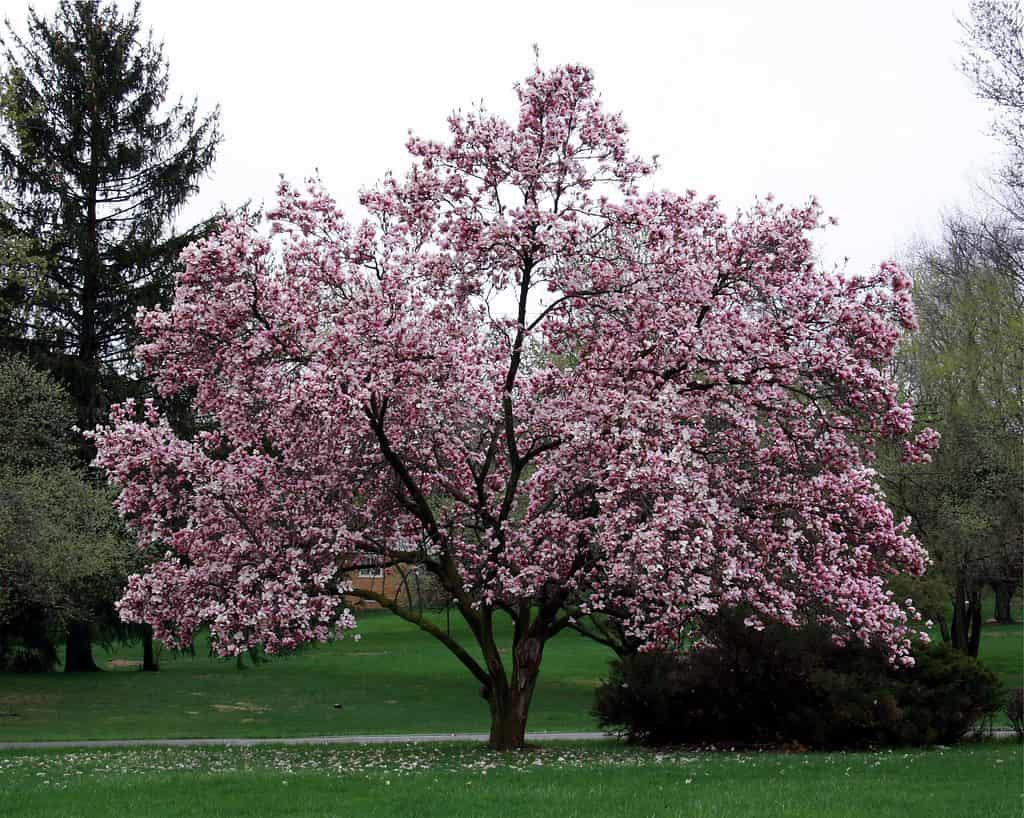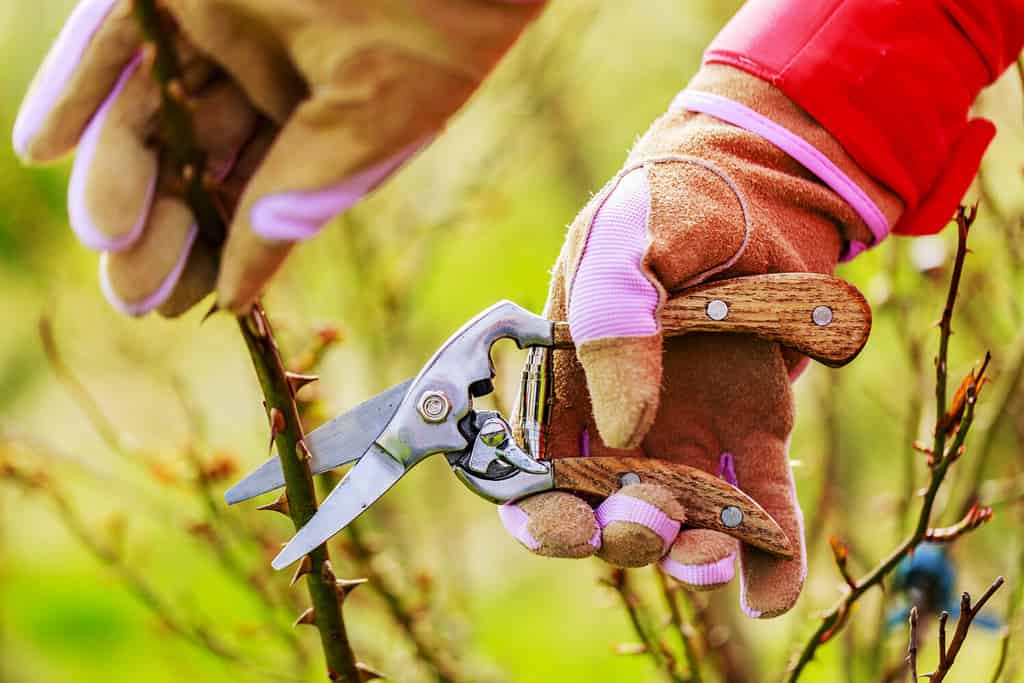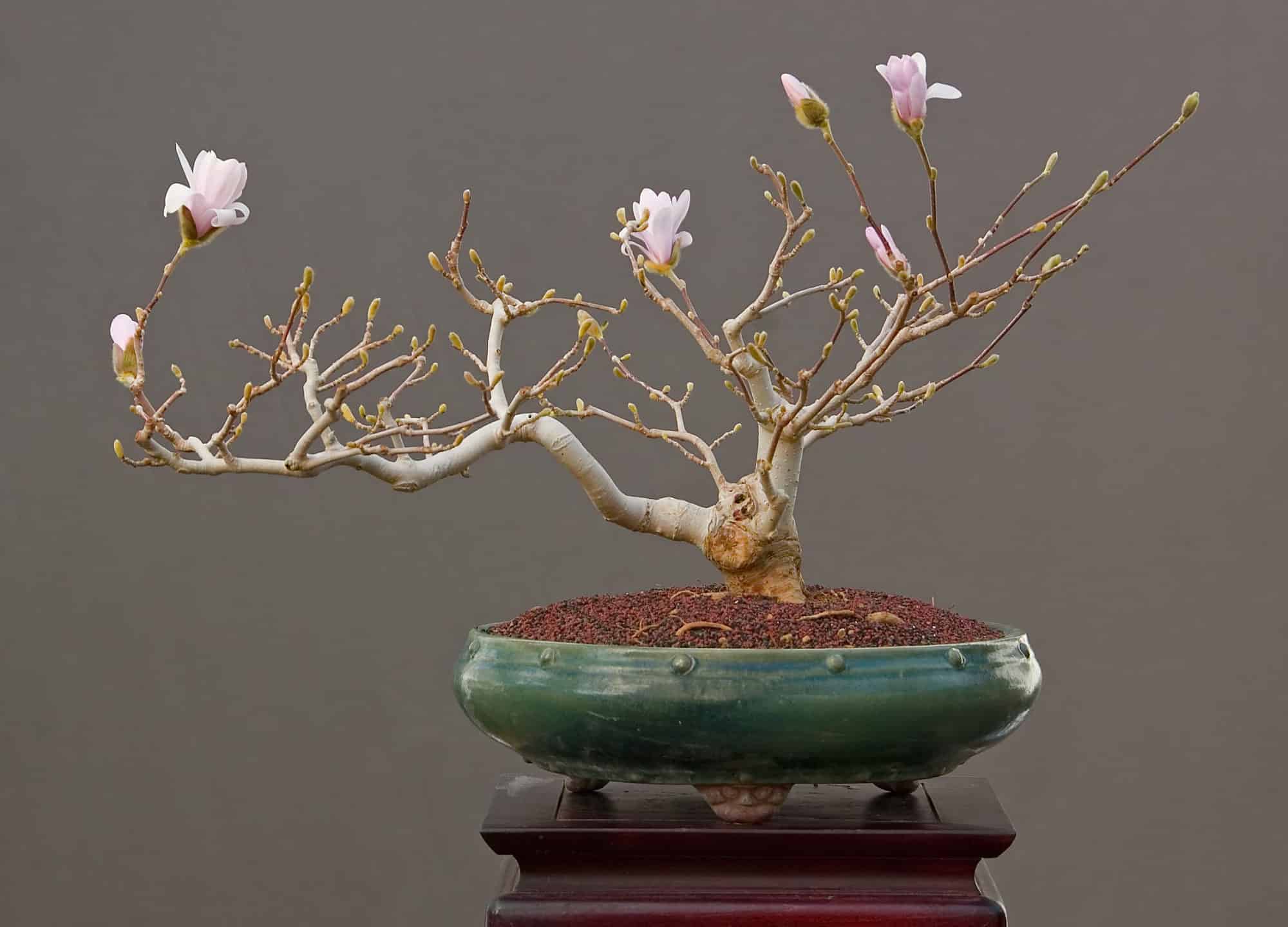Step into the enchanting world of magnolia bonsai trees, where nature’s grandeur is delicately crafted into captivating living artworks. These tiny arboreal wonders have been captivating the hearts and minds of bonsai enthusiasts for centuries. Embodying grace and beauty, magnolia bonsai trees exude an aura of timeless elegance that enchants onlookers with every glance.
In this article, we will explore the mesmerizing allure of magnolia bonsai trees and delve into the art of cultivating and caring for these miniature marvels. From their origins steeped in Eastern tradition to their widespread popularity across the globe, we will uncover the secrets behind their enduring charm.
Quick Information on Magnolia Bonsai Trees
| Magnolia Bonsai Tree Facts | |
|---|---|
| Botanical Name | Magnolia stellata |
| Popular Options | Gold Star, Centennial, Royal Star |
| Sunlight | Full or partial sun |
| Soil | Moist but well-draining |
| Water | Once per week |
| For Beginners? | Yes |
| Indoors or Outdoors? | Yes, but only in places with mild cold. |
| Pairs Well With… | Camellias, Daffodils, Calla lilies |
Common Types of Magnolia Bonsai Trees
Magnolia bonsai trees are a captivating and popular choice among bonsai enthusiasts due to their elegant beauty and sweet-scented blooms. These miniature versions of the magnificent magnolia trees found in nature can add a touch of grace and charm to any space. Let’s explore some common types or varieties of magnolia bonsai trees that are cherished for their unique characteristics and appealing features.
1. Southern Magnolia (Magnolia grandiflora)
The Southern Magnolia is one of the most well-known and cherished varieties of magnolia bonsai trees. Its large, glossy leaves, measuring up to 8 inches long, make it instantly recognizable. The plant produces stunning white flowers with a delightful fragrance, which blossom from late spring through early summer. This variety thrives in warm climates and prefers bright, indirect sunlight.
2. Saucer Magnolia (Magnolia x soulangeana)
The Saucer Magnolia, also known as the Tulip Magnolia, is a favorite among bonsai enthusiasts for its eye-catching and colorful blooms. The flowers of this variety are cup-shaped, resembling saucers, and come in various shades, including pink, white, and purple. Saucer Magnolias bloom in early spring and are a perfect choice for cooler climates. They enjoy partial shade and well-draining soil.
3. Jane Magnolia (Magnolia x ‘Jane’)
The Jane Magnolia, a hybrid variety, is admired for its compact size and profusion of striking purple-red flowers. Its petite stature makes it an ideal candidate for bonsai cultivation, especially for those with limited space. The Jane Magnolia blooms in early to mid-spring and thrives in full sunlight to partial shade.
4. Star Magnolia (Magnolia stellata)
The Star Magnolia is a captivating variety that boasts beautiful star-shaped flowers in shades of white or light pink. It is one of the earliest blooming magnolias, often gracing the landscape with its delicate blossoms in late winter or early spring. This variety prefers a sheltered spot with well-draining soil and moderate sunlight.
5. Kobus Magnolia (Magnolia kobus)
The Kobus Magnolia is a native of Japan and is admired for its delicate white flowers with a pleasant fragrance. The blooms appear in late winter to early spring, adding a touch of elegance to the bonsai garden during the cooler months. This variety thrives in full sun to partial shade and prefers moist, well-drained soil.

Magnolia trees can get quite large when not being used as bonsai trees.
©shootz photography/Shutterstock.com
Caring For Your Magnolia Bonsai Tree
Sunlight
Magnolia bonsai trees thrive in bright, indirect sunlight. Place your bonsai in a location that receives ample light throughout the day. While they appreciate sunlight, it’s essential to protect them from harsh, direct rays, as this can scorch the leaves and harm the plant.
Water
Proper watering is crucial for magnolia bonsai trees. Allow the soil to dry slightly between waterings to prevent overwatering, which can lead to root rot. On the other hand, avoid underwatering, which can cause the tree to weaken and the leaves to yellow.
To determine when to water, insert your finger about an inch into the soil. If it feels dry, it’s time to water. Use a watering can or a gentle spray to water the soil around the tree’s base, avoiding wetting the leaves.
Soil
Magnolia bonsai trees prefer a well-draining soil mix to avoid waterlogged roots. A blend of standard bonsai soil, perlite, and pine bark works well. This mixture allows for proper aeration and drainage while retaining essential moisture.
Fertilizer
Regular fertilization is necessary to provide essential nutrients for your magnolia bonsai. During the active growing season, use a balanced, water-soluble fertilizer every two to four weeks. In the dormant season, reduce the frequency to once a month or suspend fertilization altogether.
Pruning
Pruning is essential to shape and maintain the appearance of your magnolia bonsai tree. Regularly remove any dead, damaged, or diseased branches to keep the tree healthy and prevent the spread of infections. Use sharp, clean pruning shears or scissors to make precise cuts just above a bud or node.
Humidity
Magnolia bonsai trees appreciate a humid environment, especially during dry seasons or in areas with low humidity. To increase humidity, mist the leaves occasionally or place the bonsai on a humidity tray filled with water and pebbles. This will help maintain moisture around the tree.
Temperature
Magnolia bonsai trees are generally hardy, but they may need protection from extreme temperatures. During winter, ensure the bonsai is sheltered from freezing temperatures, as prolonged exposure can cause stress and damage.
Repotting
Repotting your magnolia bonsai is essential to refresh the soil, promote root growth, and keep the tree healthy. Repot every two to three years during the early spring, just before new growth begins. Trim back the roots and replant the bonsai in fresh soil, being careful not to disturb the root ball excessively.
Pruning Your Magnolia Bonsai Tree
Pruning is a vital aspect of caring for magnolia bonsai trees. When done correctly, it helps maintain their shape, promote healthy growth, and enhance their overall appearance. However, improper pruning can harm the tree and disrupt its natural beauty. Let’s explore the proper way to prune magnolia bonsai trees, ensuring their well-being and longevity.
1. Timing of Pruning
Timing plays a crucial role in pruning magnolia bonsai trees. The best time for pruning is during late winter or early spring, just before new growth begins. This period ensures that the tree has enough time to recover and heal wounds before entering its active growth phase. Avoid pruning in the fall or late summer, as it may lead to excessive stress on the tree and increase the risk of disease or pest infestation.
2. Choose the Right Tools
Using the proper tools is essential for effective and clean pruning. A sharp pair of bonsai shears or pruning scissors are ideal for precise cuts without causing unnecessary damage to the tree. Avoid using dull or rusty tools as they may crush or tear the branches, leaving the tree vulnerable to infections.
3. Remove Dead or Diseased Branches
Begin pruning by removing any dead, damaged, or diseased branches. These branches not only mar the appearance of the bonsai but can also affect the health of the entire tree. Make clean cuts close to the trunk or main branch to promote quick healing.
4. Shape the Bonsai
Shaping is a key aspect of pruning magnolia bonsai trees to maintain their desired form. Start by identifying the branches that disrupt the tree’s silhouette or create overcrowding. Carefully trim back these branches, keeping the tree’s natural structure in mind. Step back occasionally to assess the tree from different angles and ensure a balanced and aesthetically pleasing shape.
5. Consider Branch Direction and Length
When pruning magnolia bonsai trees, consider the direction and length of the branches. Aim for outward-facing buds when making cuts to encourage new growth to extend away from the center of the tree. Trim back branches that are too long or growing inwards to maintain a well-proportioned and open canopy.
6. Avoid Over-Pruning
Over-pruning can weaken the tree and inhibit its ability to thrive. Avoid removing more than one-third of the tree’s foliage during a single pruning session. Instead, opt for regular, lighter pruning sessions throughout the year to gradually shape and maintain the bonsai’s appearance.

Pruning is a very specific and particular process in maintaining bonsai trees.
©gorillaimages/Shutterstock.com
Propagating Your Magnolia Bonsai Tree
Propagating magnolia bonsai trees is a rewarding and fulfilling experience that allows bonsai enthusiasts to create new trees from their existing ones. While it may require some patience and care, successful propagation can lead to the expansion of one’s bonsai collection. One can easily propagate magnolia bonsai trees by following the steps below.
1. Choose the Right Time for Propagation
The best time to propagate magnolia bonsai trees is during the early spring or late winter when the tree is still dormant. This period allows the newly propagated tree to establish its root system and adapt before the active growing season begins.
2. Gather the Necessary Supplies
To propagate magnolia bonsai trees, gather the following supplies:
- Sharp pruning shears or a sharp knife for making clean cuts.
- Rooting hormone to encourage the development of roots on the cutting.
- A well-draining potting mix suitable for starting cuttings.
- A small container or pot with drainage holes for planting the cutting.
- Clear plastic or a plastic bag to create a humid environment for the cutting.
3. Take a Healthy Cutting
Select a healthy branch from the parent magnolia bonsai tree. The cutting should be approximately 6 to 8 inches long and taken from a branch that is not too young or too old. Make a clean, angled cut just below a leaf node using sharp pruning shears or a knife.
4. Apply Rooting Hormone
Dip the cut end of the magnolia cutting into rooting hormone powder. This will encourage the development of roots, increasing the chances of successful propagation.
5. Plant the Cutting
Insert the treated end of the cutting into a small container filled with well-draining potting mix. Gently firm the soil around the cutting to ensure it stands upright. Water the cutting thoroughly to settle the soil.
6. Create a Humid Environment
To create a humid environment that aids in root development, cover the container with clear plastic or place the cutting inside a plastic bag. This will help retain moisture and maintain humidity around the cutting.
7. Provide Indirect Light
Place the container in a location that receives bright, indirect light. Avoid placing the cutting in direct sunlight, as this may cause it to dry out or wilt.
8. Monitor and Care for the Cutting
Regularly check the cutting for signs of growth and monitor the soil’s moisture level. Ensure the soil remains moist but not waterlogged to prevent rotting. Mist the cutting and the inside of the plastic covering occasionally to maintain humidity.
9. Transplanting the Rooted Cutting
After several weeks, the cutting should develop roots. To check for root growth, gently tug on the cutting; if you feel resistance, roots have likely formed. Once the cutting has established a healthy root system, carefully transplant it into a bonsai pot with well-draining soil.
Common Problems with Magnolia Bonsai Trees
Magnolia bonsai trees are captivating and rewarding additions to any bonsai collection, but like all plants, they are susceptible to various issues that can affect their health and beauty. As a gardener, being aware of these common problems and knowing how to address them is crucial for ensuring the well-being and longevity of your magnolia bonsai.
Pest Infestations
Pests can be a persistent problem for magnolia bonsai trees, causing damage to the leaves and weakening the overall health of the tree. Common pests that gardeners may encounter include aphids, scale insects, and spider mites. These tiny creatures can quickly multiply and wreak havoc on the bonsai.
Regularly inspect your magnolia bonsai for signs of pest infestations. If you spot any pests, act promptly to prevent the problem from escalating. A strong jet of water can help dislodge small pests, or you can manually remove them using a soft cloth. For more significant infestations, consider using organic insecticidal soap or horticultural oils. Follow the instructions carefully to avoid harming the tree.
Fungal Diseases
Fungal diseases can pose a threat to magnolia bonsai trees, especially in conditions with high humidity or poor airflow. Common fungal issues include powdery mildew and leaf spot diseases. These diseases can lead to discolored leaves, white powdery substances on the foliage, and premature leaf drop.
Improve air circulation around the bonsai to reduce humidity levels and prevent fungal growth. Water the plant at the base to avoid wetting the leaves, which can encourage fungal growth. If fungal diseases are present, remove and dispose of the affected leaves. Apply a suitable fungicide according to the instructions on the label to control the spread of the disease.
Yellow Leaves
Yellowing leaves on a magnolia bonsai may indicate various underlying issues, such as overwatering, underwatering, nutrient deficiencies, or root problems. Identifying the specific cause is essential to effectively address the problem.
Review your watering routine and adjust it accordingly to avoid overwatering or underwatering. Ensure the bonsai’s soil is well-draining to prevent waterlogged roots. Regularly feed the tree with a balanced fertilizer to provide essential nutrients. If yellowing leaves persist, carefully inspect the root system for any signs of damage or disease.
Winter Stress
Winter can be a challenging time for magnolia bonsai trees, especially in colder climates. The tree may experience stress due to freezing temperatures, resulting in leaf drop and weakened growth.
Protect your magnolia bonsai during winter by providing extra insulation. Wrap the pot with burlap or place the bonsai in a sheltered location away from harsh winds. Water the tree sparingly during the winter months to prevent root rot.
Bad Pruning
Improper pruning can harm the magnolia bonsai, affecting its shape, structure, and overall aesthetics. Over-pruning can weaken the tree, while incorrect cuts can lead to disease and decay.
Learn proper bonsai pruning techniques or seek guidance from experienced bonsai enthusiasts or horticulturists. Make clean cuts just above a bud or node to encourage healthy growth and maintain the desired shape of the bonsai.
Thank you for reading! Have some feedback for us? Contact the AZ Animals editorial team.








